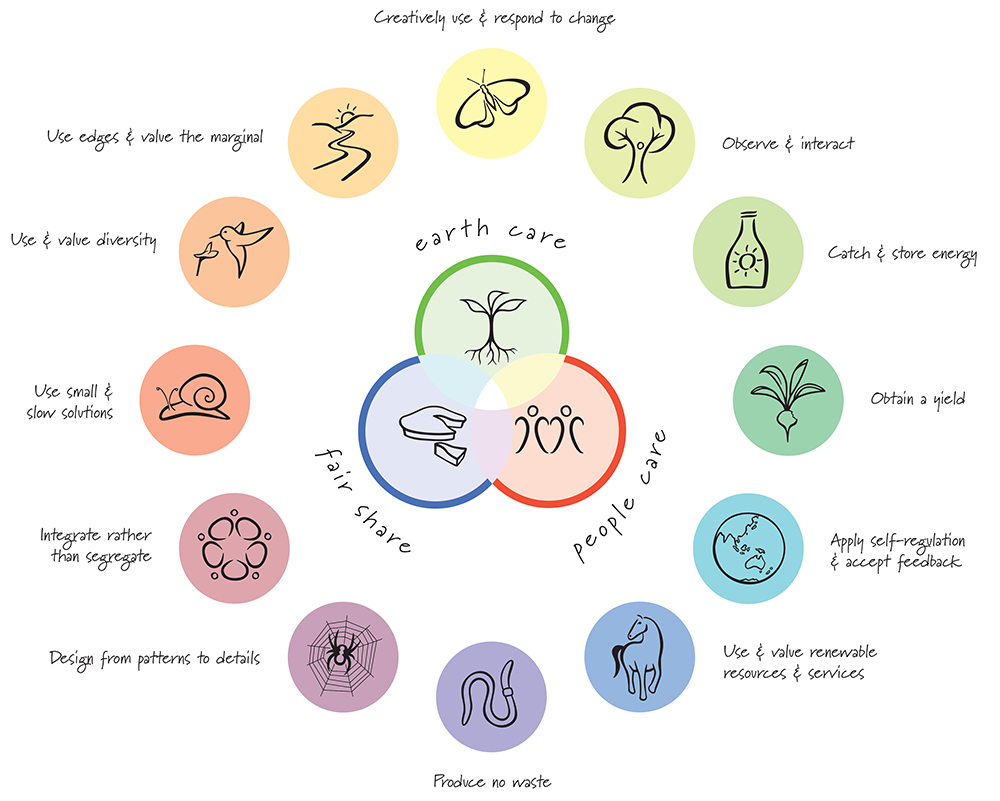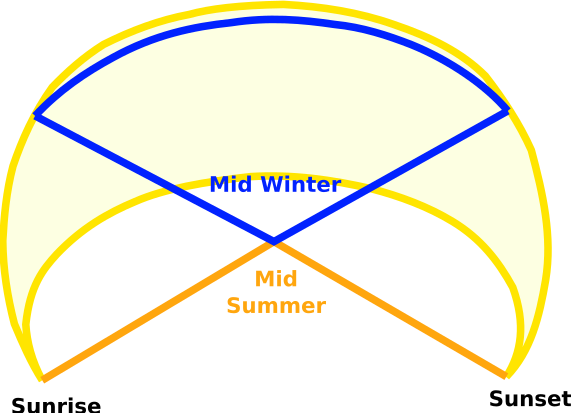Permaculture
Permaculture is a set of design principles for creating a sustainable and resilient way of living. The discipline of permaculture design starts by observing natural systems and processes and how they sustain themselves. By applying these natural principles to the design of farms, gardens, buildings, woodlands, communities, businesses, towns and cities we can be more productive for less effort, reaping benefits for our environment and ourselves, for now and for generations to come.
Permaculture is essentially the design of an ecologically sound way of living by working in harmony with nature to care for the earth and its people.
Permaculture is not a dogma or a religion but an ecological design system which helps us find solutions to the many problems facing us. Permaculture encourages us to be resourceful and self-reliant. It has at its core the ethics of Earth Care, People Care, and distribution of Fair Share.
The word Permaculture comes from “Permanent Agriculture” and was developed in the 1970s in response to the increasing industrialisation of agriculture. The founders, Bill Mollison and David Holmgren, recognised this as unsustainable. Since then the use of the principles has grown and they are now being applied in many areas to develop sustainable systems eg food production, housing, urban design, community creation.
Its goals and priorities coincide with what many people see as the core requirements for sustainability.
Its principles are being constantly developed and refined by people throughout the world in very different climates and cultural circumstances. For many it's become a way of life. The ethics are:
Earth Care
Care for all living and non living things. Making the choices of what we consume and conserve.
People Care
The basic needs for food, shelter, education, employment and healthy social relationships are met. At the core of people care is the community and how together we can achieve change
Fair share
Concerns the distribution of resources between communities and the need to limit consumption (especially of natural resources). Permaculture provides a set of guidelines that can be used in designing sustainable systems. Otherwise its merely a lifestyle choice within an existing unsustainable system.
12 design principles
Each of the 12 principles is the way into a whole system of thinking that provides a different perspective that can be understood at varying levels of depth and application. Together they allow us to creatively re-design our environment and our behaviour in a world of shrinking energy and limited resources.

Observe & Interact.
Just observing makes nothing happen. Just acting can make problems bigger and bigger. We need to balance the two
Catch & Store Energy.
We can design our landscape, our buildings, and our community to capture and retain as much energy as possible.
Obtain a Yield.
The essence of self-reliance is the ability to meet many of our own needs from our own resources.
Apply Self-regulation & Accept Feedback.
It is the self-regulatory aspects of permaculture that limit or discourage inappropriate actions and behaviours.
Use & Value Renewable Resources and Services.
It's fine to make use of renewable resources to create, manage and maintain high yielding systems, even if some non-renewable resources are needed to establish the system in the first place.
Produce No Waste.
"refuse, reduce, reuse, repair, recycle", permaculture adds in “re-design”.
Design From Patterns to Details.
Nature provides many sustainable patterns for us to follow. Observe these and create the big picture first,
Integrate Rather Than Segregate.
Permaculture seeks to integrate elements together so that the needs of one are supplied by another. e.g. close the waste loop by reusing what someone else discards. Any easy way to consider this is "How can my problem be someone else's solution"
Use Small and Slow Solutions.
Small scale solutions and activities are more likely to be adaptive to local needs, respectful of nature and able to see the consequences of actions.
Use and Value Diversity.
Permaculture always tries to incorporate a wide variety of plants, animals and approaches - if one fails, another may succeed
Use Edges and Value the Marginal.
The place where two eco-systems or habitats meet is generally more productive and richer in the variety of species present than either habitat on its own
Creatively Use and Respond to Change.
Change is one of life’s constants and it is how we respond to change that creates resilience.
Permaculture zones
Zones decide where elements of the design are placed. Zone 0 is the house of primary gathering place. Zone 1 is where things and activities belong that are performed every day, zone 2 for aspects that are performed very regularly, zone 3 for activities that support zone 2 and are performed less frequently, zone 4 is only semi managed and used for timber and wild foods, zone 5 is a completely unmanaged wilderness which is only visited for exploration, enjoyment and research.
| Zone 1 | Zone 2 | Zone 3 | Zone 4 | Zone 5 | |
|---|---|---|---|---|---|
| Location | Near to dwelling or main building | Surrounding Zone 1 | Outside Zone 2 | Further away | Anywhere outside Zone 2 |
| Use | Provides for daily requirement e.g. workshop, kitchen garden | Main growing area | Slower, long term crops | Fruit and nuts, livestock | Wild berries, meditation space |
| Access | Easy access | Easy access, also for small machines | Convenient access | Access | Doesn't matter |
Permaculture sectors
 Sectors are another design elements and relate to the outside influences on the farm.
Sectors are another design elements and relate to the outside influences on the farm.
-
Sun: This is the obvious one. What direction does the sun rise and where does it set in both winter and summer. Are there trees or other obstructions that will block the low winter sun and create a shadow over the beds?
-
Water: As well as light crops need water to grow successfully. How much they need and how often depends on the climate and type of crop. The FAO has some good information. Experienced growers in a temperate climate can use over 40L per square metre per week in a dry summer to irrigate a variety of market garden crops. Sufficient water is of vital importance. The national weather authority may have statistics available, otherwise local weather stations may help.
-
Water flow: where does the rain that falls flow to? Does the path it will take flow near or through the gardens? The flow in summer can be very different to the flow in winter when there is often significantly more rain. Sometimes the type of vegetation can give a clue to where the water gathers and flows, but often the only way is to observe what happens in each of the seasons. It is often possible to change the direction of a flow with a shallow drain e.g. a trench alongside a garden may be enough to prevent the water flowing across the beds.
-
Wind: what is the direction of the prevailing wind and how strong and often does it blow? Where do the storm winds blow from? Where are shelter belts located? All of these are important when designing the layout of the farm. Often a wind chart can be obtained from your national weather authority. There may also be local weather stations. Failing that a chat with your neighbours may be worthwhile.
-
Noise, dust, fire: if any of these is a concern then it should be mapped.
-
Microclimates: identify pockets on the farm where the climate is different e.g. in a dip in the land.
Comment
The yield of a system is only limited by our imagination e.g. a backyard may be able to provide enough food to feed us if we design and manage it correctly. Permaculture helps us see the opportunities and gives us the tools to make things happen in the best and most sustainable way.
There is no "blueprint" for a permaculture farm design as every market garden is different. Much will depend on the way shadows fall on the land, the way water flows and the exposure to wind. The condition of the soil is of less importance as in most cases this can be amended, although it may take some time.
Consider studying for a Permaculture Design Certificate. They are run in different countries by the local permaculture group and all (should) follow more or less the same format. It is important to follow one in your own country to learn about aspects relevant to your particular environment. Here is a typical syllabus